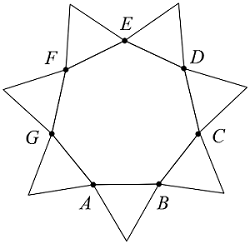SAT Triangles-Perimeter
 In the figure above,
is a regular heptagon. To each of its sides is attached an equilateral triangle. If the perimeter of
is 84, what is the perimeter of the star-shaped figure?
In the figure above,
is a regular heptagon. To each of its sides is attached an equilateral triangle. If the perimeter of
is 84, what is the perimeter of the star-shaped figure?
(A)
(B)
(C)
(D)
(E)
This section requires Javascript.
You are seeing this because something didn't load right. We suggest you, (a) try
refreshing the page, (b) enabling javascript if it is disabled on your browser and,
finally, (c)
loading the
non-javascript version of this page
. We're sorry about the hassle.
Correct Answer: D
Solution:
Tip: Perimeter of a polygon equals the sum of the lengths of its sides.
We're given that the perimeter of the regular heptagon is 84. Since it has 7 sides of equal length, the length of each side is 8 4 : 7 = 1 2 .
We're also given that to each of the heptagon's sides is attached an equilateral triangle. It follows that each side of an equilateral triangle is also 12, and that all the triangles have sides equal to 12.
To find the perimeter of the star-shaped figure, we need only count 2 of each triangle's sides, as shown in green below.
There are seven triangles. So,
perimeter of star = 2 ⋅ 7 ⋅ 1 2 = 1 6 8 .
Incorrect Choices:
(A)
Tip: Just because a number appears in the question doesn’t mean it is the answer.
If you estimate that the star's perimeter is the same as that of A B C D E F G , you will get this wrong answer.
Or, you don't account for the two sides of each triangle that contribute to the star's perimeter, that is, if you find perimeter of star = 7 ⋅ 1 2 , you will get this wrong answer.
(B)
This wrong choice is just offered to confuse you.
(C)
Tip: Read the entire question carefully.
If you think A B C D E F G is a regular hexagon (that is, it has 6 sides of equal length), you will get this wrong answer. If you don't know what a heptagon is, use the figure to count the number of A B C D E F G 's sides.
(E)
Tip: Perimeter of a polygon equals the sum of the lengths of its sides.
If you count all three sides of each triangle as contributing to the star's perimeter, you will get this wrong answer. Only two sides of each triangle determine the perimeter of the star.